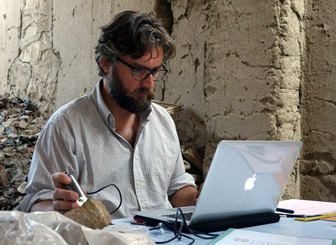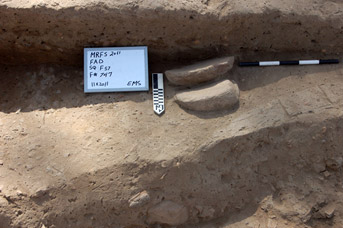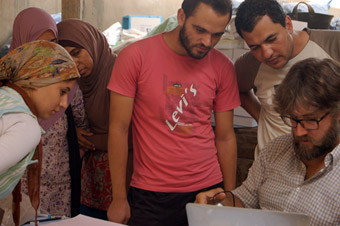By Dr. Giulio Lucarini, University of Cambridge, UK
When I spoke for the first time with Ana Tavares about the food production research project I am currently carrying out in several regions of North Africa* and, in particular, about the analysis I am doing on grinding stones, she experienced a ‘light bulb moment’ and, smiling, exclaimed: “I have finally found somebody who may be interested in our fantastic querns and grinders! Do you think we can apply the same approach to the tools coming from the ancient capital of Egypt?” She did not have to wait too long for my reply. I was absolutely delighted and honored by receiving this proposal, especially considering that the importance of stone assemblages coming from dynastic contexts is very often underestimated or, at least, not considered at the same level of other classes of materials, such as pottery. As an archaeologist and prehistorian I have to admit that making the stones ‘speak’ has always been my greatest passion and the possibility to analyze assemblages from such an important Middle Kingdom site is a new challenge for me. This is the reason why I am writing this blog today.

Giulio analyzes a grinding stone, from Middle Kingdom Memphis, with a USB microscope. Photo by Ana Tavares.
The work I have carried out during the 2014 season of the MRFS investigates potentials of grinding tools to provide information on the functional nature of different areas of the Kom el-Fakhry settlement and on dietary and non-dietary uses of such tools, by applying an integrated approach of use-wear and residue analysis.

Two large querns found in Kom el-Fakhry during the 2011 season. Photo by Essam Shehab.
During the first stage of analysis, all the pieces were analyzed from a typological and technological point of view. I have then carried out a microscopic scanning of the tools’ surface micro-topography by means of a stereomicroscope and a USB digital microscope in order to detect the presence of use-wears and possible residues associated to them. During the next season, after obtaining the necessary authorizations from the MSA, I will sample the residues that I have identified. These will be then observed in the lab under a transmitted light microscope, in order to detect the presence of plant micro remains, such as starches or phytoliths, or other kind of non-organic residues, such as pigments. A further ongoing stage, carried out with my colleague, the palaeobotanist Anita Radini from the University of York, consists in building a comprehensive reference collection of modern starch granules and phytoliths from wild and domestic plants coming from different North African regions, to be used for a correct identification of the remains found on the archaeological tools.

Although the clever students of the MRFS during these days were mainly involved in studying and drawing pottery, they often peeped the stone tools scattered on my table with very interested eyes. It would be great if one, or some of them could be trained in the next future in the analysis of lithics and grinding stones.
Anybody is interested? C’mon girls and guys…ahjar are waiting for you!
*AGRINA – Human transitional pathways towards food production in North Africa: Technological and environmental signatures
